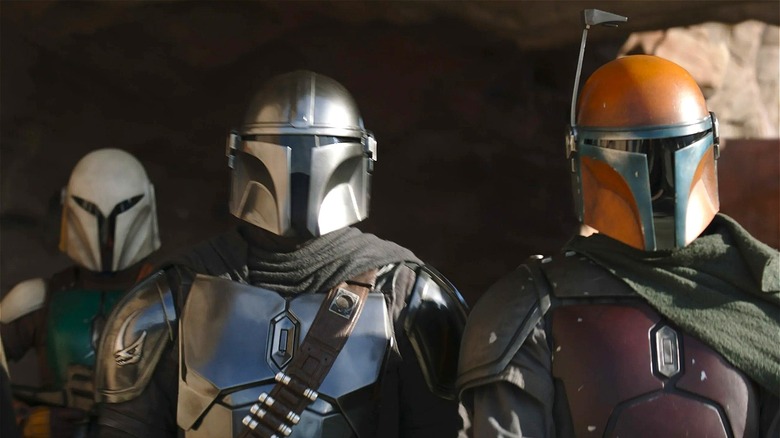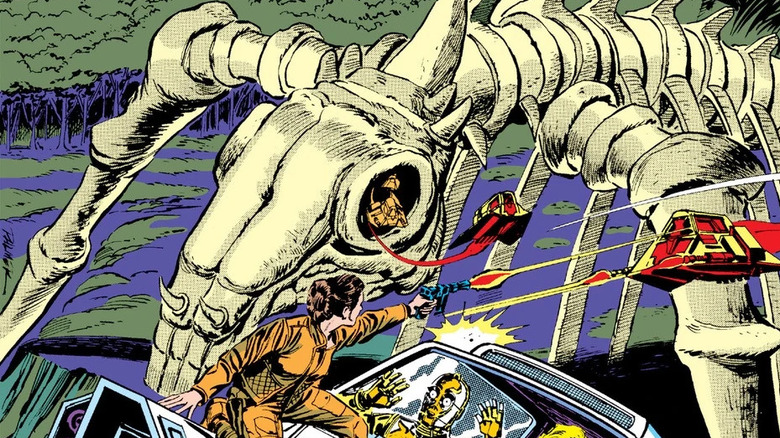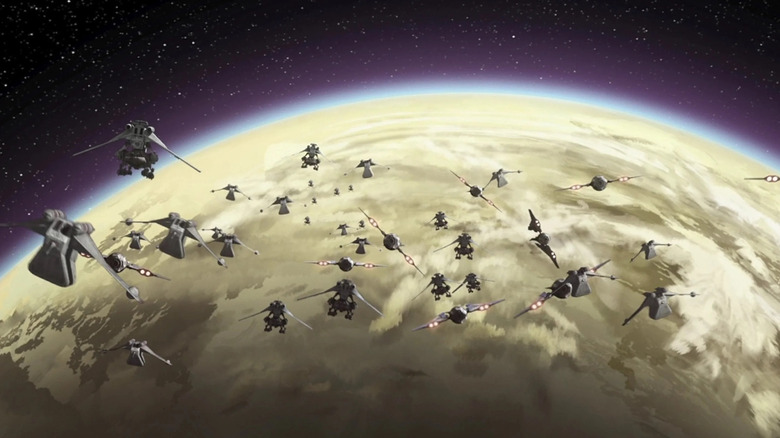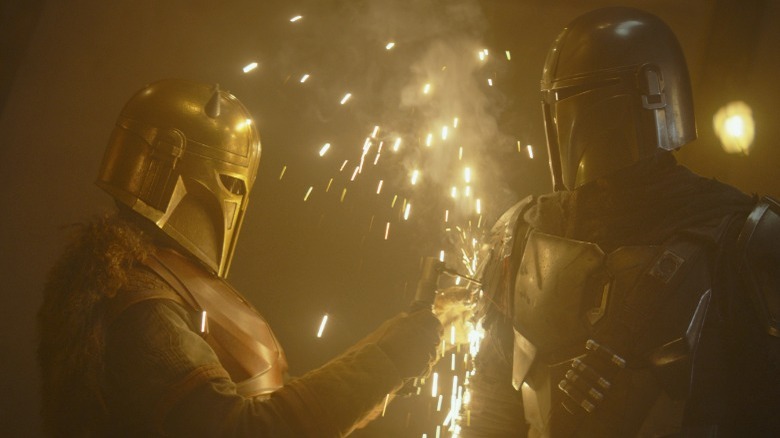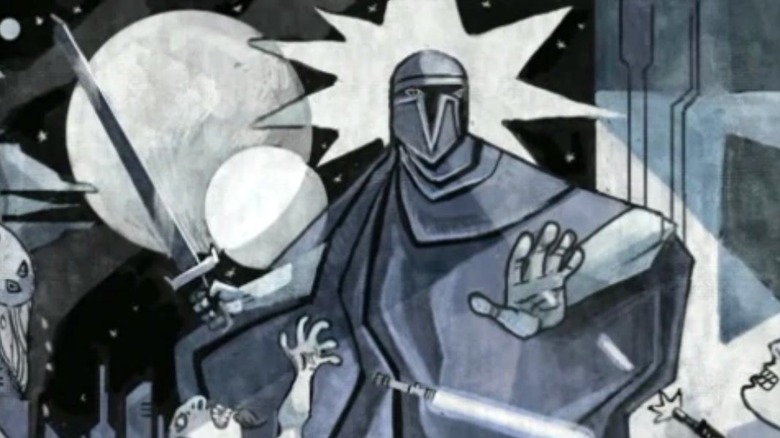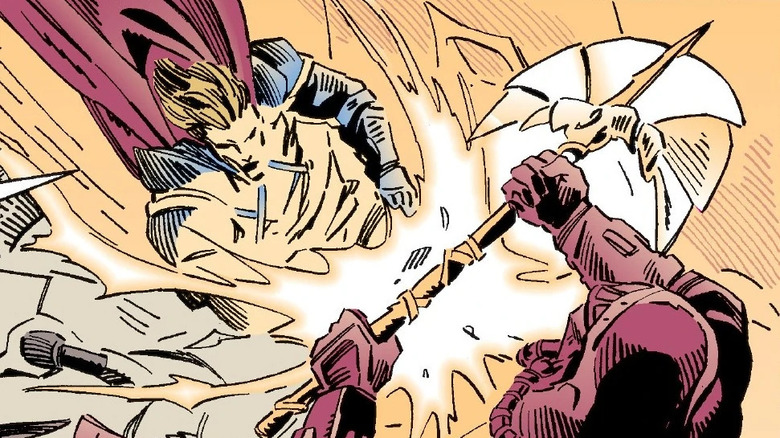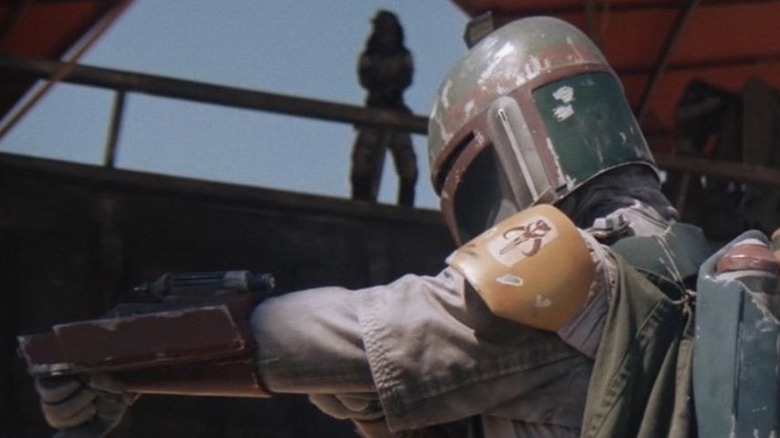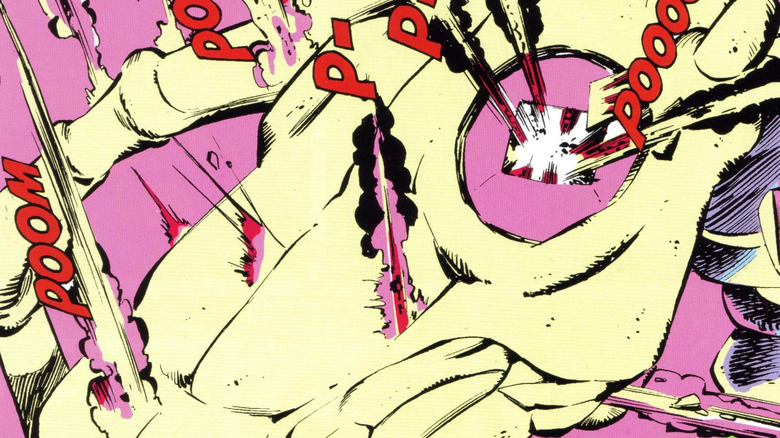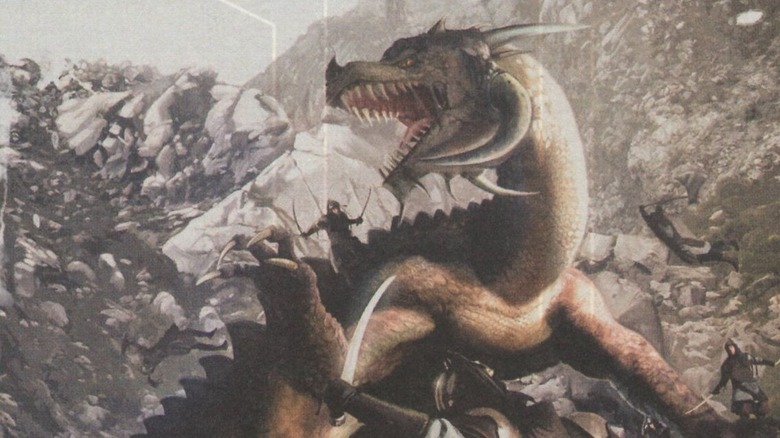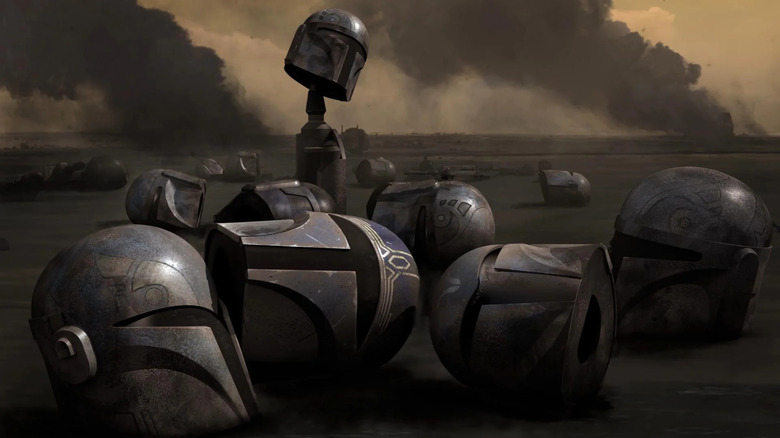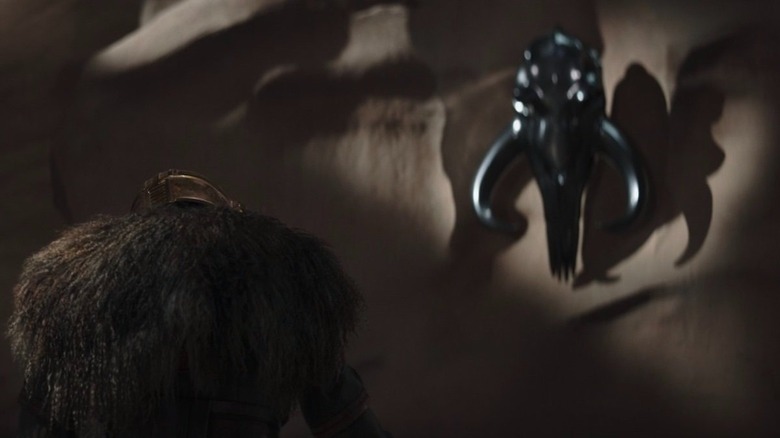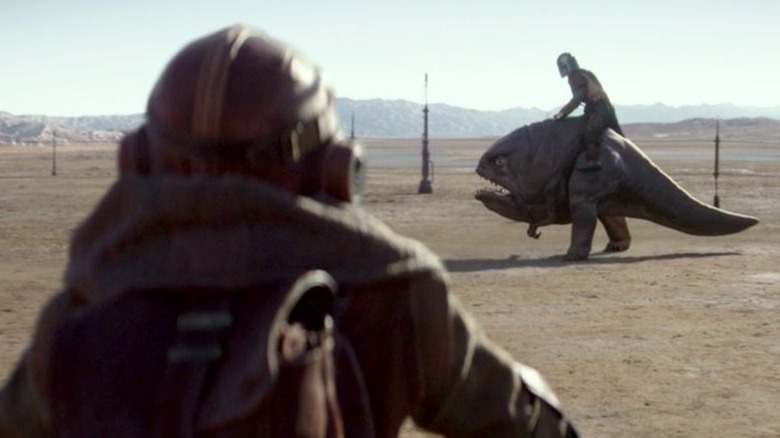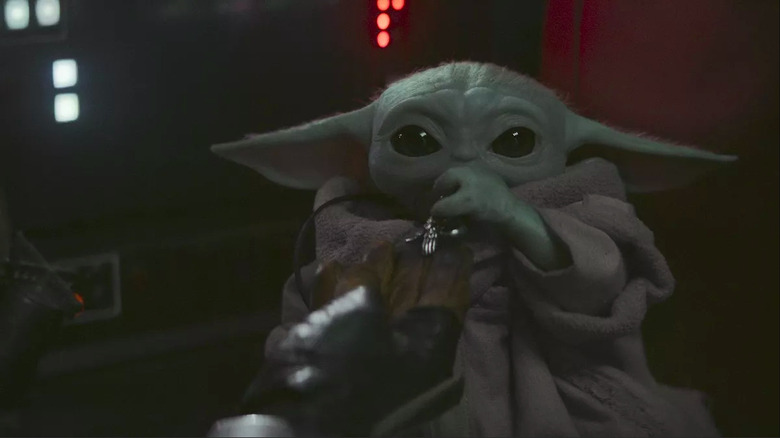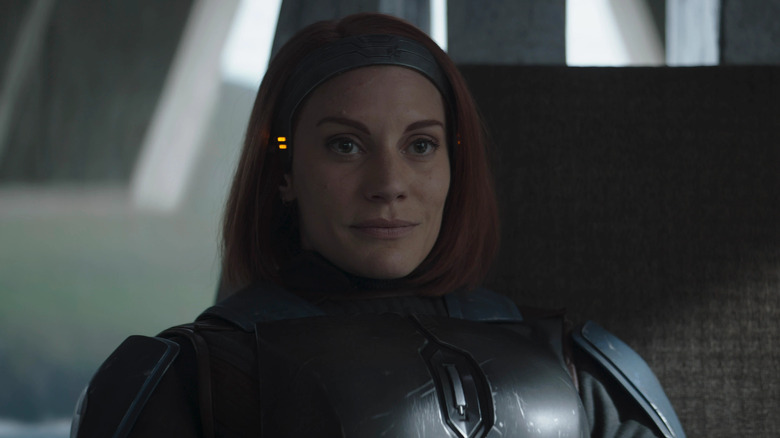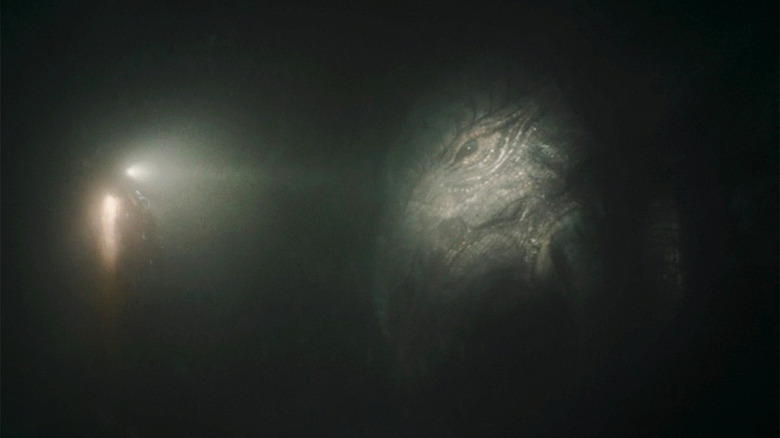The Mandalorian's Mythosaur Holds Deeper Meaning Than You Thought
Season 3 of "The Mandalorian" is officially underway and based on the first few episodes to be released, this season will be the biggest yet. The "Star Wars" Disney+ series began in 2019 starring Pedro Pascal as the titular bounty hunter who risks his life protecting a force-sensitive creature named Grogu from warring factions across the galaxy.
One of the key aspects that makes "The Mandalorian" beloved by "Star Wars" fans is how it ties together aspects of the franchise's extended universe. The show features characters returning from the original trilogy, as well as "Star Wars: The Clone Wars" veterans like Bo-Katan and Ahsoka Tano. Elsewhere, the show elaborates on sides of the "Star Wars" universe rarely seen across its nine core films while exploring unknown lore, particularly that relating to the Mandalorian culture of which Pascal's Din Djarin is a part.
However, "Chapter 18: The Mines of Mandalore" features one of the show's biggest reveals yet — the debut of the legendary Mythosaur. This potentially has greater implications for the "Star Wars" universe than Luke Skywalker's cameo at the end of Season 2, but many casual "Star Wars" fans may not have even heard of a Mythosaur.
From its inception to its symbolic presence in Mandalorian mythology, here is everything "Star Wars" fans need to know about the Mythosaur, which might be Din Djarin's greatest challenge yet.
The Mythosaur first appeared in a comic book from 1982
The first appearance of the Mythosaur in the "Star Wars" extended universe dates back before the conclusion of the original trilogy. Beginning in 1977, Marvel Comics ran a comic series following the film franchise's central cast that ran until 1986. As a whole, the series ran for 108 issues, but the first sighting of the Mythosaur, albeit indirectly, came in "Star Wars" #69, published in December 1982.
In the issue, Princess Leia and C-3PO find themselves captives of the Empire and taken to the mysterious Imperial fortress known as the City of Bone shortly after the events of "Star Wars: The Empire Strikes Back." There, they ally themselves with Fenn Shysa, a Mandalorian soldier and veteran of the Clone Wars, after helping him free his fellow soldier Tobbi Dala. As described in the comic, the City of Bone was built inside the skeleton of a massive beast and had been converted by the Empire into a prison.
The history of the Mandalorians was more thoroughly revealed in a 2005 article for Star Wars Insider titled "The History of the Mandalorians," which established that the City of Bone's monstrous skeleton was actually that of a Mythosaur, the ancient sigil of the Mandalorian people. However, given that this wasn't established for years after the comic's release, it remained canonically an unknown fortress of the Imperial Guard for decades.
Mythosaurs originate from the Outer Rim planets
The Mythosaur is closely tied to the origin of the Mandalorian people, with the species originating on an unnamed planet in the Outer Rim. As "Star Wars" fans will know, the Outer Rim consists of mostly uncharted territory for a majority of the "Star Wars" universe, with planets containing primitive civilizations, natural wildlife, as well as various pirates and raiders. Given the rarity of sentient life on planets like these, the Mythosaur thrived as the dominant species on the planet until the unexpected arrival of settlers.
The Mythosaurs' planet, which would later be named Mandalore after the leader of the first settlers and the namesake for the Mandalorians, was at first little more than a gold mine for the future warriors. The planet contained untapped resources such as near-endless mines of beskar, which the Mandalorians would later use to make their signature weapons and armor. The planet's moons, like Concordia, would also become home to fragmented factions of the Mandalorian tribe, such as the one Din Djarin was a part of.
Still, for what might've been thousands of years, the Mythosaurs dominated the planet's environment, which included a diverse array of biomes including jungles, caves, and mountains. The Mythosaur wasn't the only predatory species around, either, as birds of prey known as shriek-hawks also roamed the planet's skies. Nevertheless, these creatures would be the only obstacles preventing the early Mandalorian tribes from conquering this planet as their new home.
Mandalore the First sought to conquer the Mythosaur
The Mythosaurs as a species faced danger when settlers came to their planet under the leadership of Mandalore the First. Mandalore and his followers were Taungs, who had fled their native planet of Coruscant and settled on Roon in the Outer Rim. Soon enough, they set their sights on neighboring worlds, which included the one which would later be named after Mandalore. They sought to conquer the lands and its wildlife, including the mighty Mythosaur.
Mandalore the First and his followers would come to be known as the Mandalorian Crusaders, who "Star Wars" fans know to be deeply involved in wars between the Sith and the Jedi in the "Star Wars" extended universe. For the Mandalorian Crusaders to be seen as truly formidable foes, they had to prove their power, which is exactly what Mandalore the First had in mind when he and his followers first arrived on the Mythosaurs' planet.
According to "Star Wars: The Essential Atlas," a profile of planets in the "Star Wars" universe released in 2009, the Mythosaurs were domesticated by Mandalore the First and his army, who later rode them before continuing to slaughter them into extinction. In "The Mandalorian," this warrior figure, referred to by Bo-Katan as Mandalore the Great, tamed the creatures, potentially setting up for Din Djarin to embody a similar role in future episodes of the Disney+ show.
The extinction of the Mythosaur led to the formation of the Mandalorians
Unfortunately for the Mythosaur species, their extinction would be a necessary step towards the formation of the Mandalorian tribe. As described in "Star Wars: The Essential Atlas," by the time the primitive Mandalorians were finished conquering the planet, all that was left of the Mythosaurs were their skeletons. However, this gave way for the Mandalorians to finally become the Mandalorians, with Mandalore the First naming their tribe after himself and designating the warring leadership role as Mand'alor. They even began to adopt their own language, named Mando'a.
These primitive Mandalorians became notable for their technology, which would come in handy during their wars against the Jedi. For now, the conquests of the early Mandalorians wouldn't stop with the planet Mandalore, as they decided to keep it as their home base and venture out across the galaxy for more to conquer.
Sadly, although the Mythosaur had to become extinct for the Mandalorians to stake their first claim into an uninhabited planet, their home would eventually become abandoned as the warriors turned their attention towards other worlds. Once Mandalore the First was gone, he was replaced by future leaders like Mandalore the Conqueror, who led their early military campaigns, and Mandalore the Indomitable, one of the most significant Mandalorians in the history of the "Star Wars" extended universe.
The Mandalorians made weapons out of Mythosaur bones
The early Mandalorian tribes made good use of the Mythosaur skeletons left in the wake of Mandalore the First's conquest. Prior to adopting beskar as their signature material, Mythosaur bones were commonly used by early Mandalorians for weapons and armor. One particular weapon was the Mythosaur axe, notable for its rounded blade made of calcified Mythosaur bone. Though it was mainly regarded as a traditional weapon used for ceremonies, some significant Mandalorians used it in combat.
One such user of the Mythosaur axe was Mandalore the Indomitable, whose legacy was ruthless bloodshed with no known motivation other than survival. In "Tales of the Jedi," a comic book published by Dark Horse Comics, Mandalore the Indomitable features during his prominent crusade against the Empress Teta system as part of the Sith Wars. In one of Mandalore's many battles during this conquest, he challenged his opponent, the Jedi Knight Qel-Droma, to a duel using Mythosaur axes instead of lightsabers.
To the shock of Mandalore the Indomitable, who had rigged the battle in his favor, Qel-Droma bested the bloodthirsty Mandalorian with the Mythosaur axe, forcing Mandalore the Indomitable to surrender, asking for his life to be taken by the victor. Qel-Droma, in an act of mercy, spared Mandalore's life but proved that the Jedi were not to be trifled with, no matter what ancient Mandalorian weapon was used.
The Mythosaur becomes the insignia for Mandalorian clans
Following the Mythosaur's extinction, the monster's skull became a common sigil of the Mandalorian tribe. It began, as all things with the Mandalorians, with Mandalore the First, who created a ceremonial mask out of the beast's carved bones. This ceremonial mask became a crown of sorts for future Mand'alor leaders, a tradition that continued with Canderous Ordo, a Mandalorian who appears in the video game "Star Wars: Knights of the Old Republic."
Fans of "The Mandalorian" likely recognize the insignia hanging in the Armorer's smithy under the trade city of Nevarro. It's commonly adorned by members of the Mandalorians in ways like this, dating all the way back to the original trilogy. Boba Fett, who debuted in "Star Wars: The Empire Strikes Back" and also appeared in "Star Wars: Return of the Jedi," had the Mythosaur logo incorporated into one of the character's shoulder plates.
The sigil of the Mythosaur was also used by many factions of Mandalorians, including the ancient Keldau clan, known for their warrior peoples. An updated version of the insignia was also used by the Mandalorian Neo-Crusaders, who included Canderous Ordo as one of their leaders. While the Mythosaur was regarded as a symbol of Mandalorian pride and their history, it wouldn't take long for a member of the clan to use the monster's likeness for nefarious purposes.
The City of Bone is built by a Mandalorian entrepreneur
Although the City of Bone, which unknowingly introduced the Mythosaur into the "Star Wars" canon back in 1982, is designed to look like the beast's skeleton, many "Star Wars" fans would be surprised to learn that it's not authentic. In the Marvel Comic, the City of Bone is used as a fortress by the Galactic Empire to house prisoners such as Princess Leia or the Mandalorian rebels Fenn Shysa and Tobbi Dala. However, it wasn't until a 2009 novel that revealed what the true origin of the Imperial stronghold was.
According to "Imperial Commando: 501st", written by Karen Traviss, the City of Bone was constructed by an unknown Mandalorian who saw the capitalistic potential for the planet of Mandalore. The Mythosaur skeleton was a replica created to entice tourists, with the plan to build an amusement park in it, which was later abandoned. Following the end of the Clone Wars, the Empire found the Mythosaur skeleton and mistook it for a temple to ancient Mandalorian gods.
However, its appearance in "Star Wars" #69 saw the destruction of the Mythosaur replica thanks to the sacrifice of Tobbi Dala, who allowed Leia, C-3PO, and Fenn Shysa to escape through the City of Bone's eye socket. Though this adventure, which takes place in between "Star Wars: The Empire Strikes Back" and "Star Wars: Return of the Jedi," is never depicted in the movies or shows, it's an epic tale of Mandalorian greatness.
A 2013 book on bounty hunters depicts the first living Mythosaur
Although the Mythosaur skeleton gave "Star Wars" fans an idea of what the monster looked like all the way back in 1982, a Mythosaur's appearance in its prime wasn't depicted until 2013. Two years before the revival of the "Star Wars" film franchise with J.J. Abrams' "Star Wars: The Force Awakens," the reference book "The Bounty Hunter Code: From the Files of Boba Fett" was released. Designed to be an in-universe publication detailing the many bounty hunters that Boba Fett has encountered throughout his adventures, it contains lots of information about Mandalorian history.
Thanks to the artistry of designer Brian Rood, fans finally got an epic glimpse at the monster who was conquered by Mandalore the First and his army. In a picture from the book, the Mythosaur is being ridden by a dual-wielding ancient Mandalorian, surrounded by an army of clothed warriors on a mountain. One can imagine what it must've looked like for those Mandalorian conquerors to not only tame these vicious beasts but to exterminate them as a species completely.
Thankfully, fans no longer have to imagine thanks to "The Mandalorian," which is primed to show more of the Mythosaur now that the beast has been revealed to lurk in the waters of Mandalore's mines. The monster as it appears in the Disney+ show already bears resemblance to the artwork from "The Bounty Hunter Code," complete with the two horns that adorn the now-iconic Mandalorian insignia.
Mandalore is destroyed during a sequence of wars
However, just as the Mandalorians had eradicated the Mythosaur from their home, the Mandalorians would eventually suffer the same fate. The Mandalorians engaged in a civil war which was the focus of the animated series "Star Wars Rebels." The conflict is at the forefront of the series' Season 4 premiere, "The Heroes of Mandalore," which depicts Bo-Katan inheriting the Darksaber and claiming rulership over Mandalore.
Unfortunately for Bo-Katan, the Mandalorians become the target of the Galactic Empire, with forces led by the evil Moff Gideon, played by Giancarlo Esposito in "The Mandalorian." Knowing the Mandalorians were too powerful compared to the rest of the galaxy, Gideon's army committed a genocide that later became known as "The Great Purge of Mandalore." Despite the efforts of the surviving Mandalorian army, Mandalore was devastated by Imperial TIE Bombers, while Moff Gideon won the Darksaber from Bo-Katan in combat during the Night of a Thousand Tears.
The destruction of Mandalore led to the belief that the planet was cursed and poisoned for many years leading up to the events of "The Mandalorian." However, as revealed in the most recent episode, the planet still contains breathable air and even surviving wildlife in the form of a submerged Mythosaur. Hopefully, "The Mandalorian" is set to revive Mandalore to what it was before it was torn apart by war.
The Mythosaur becomes a symbol for Mandalorian rebirth
Over the years following the Great Purge of Mandalore, the Mandalorians became scattered across the galaxy. Division between various Mandalorian factions was at an all-time high. On the moon Concordia, a foundling named Din Djarin was raised by the Children of the Watch, who Bo-Katan refers to in "The Mandalorian" as zealots who broke off from the rest of the Mandalorian people, who she knew as the Death Watch during the days of "Star Wars: The Clone Wars."
Din Djarin later becomes the helmeted father figure at the center of "The Mandalorian" and joins a hidden Mandalorian cult known as the Tribe, which is led by the Armorer. Fans of "The Mandalorian" will recall the significance of the Armorer hanging the Mythosaur insignia on the wall of her cave during the Tribe's occupation of Nevarro in the first season. The Great Purge has turned any and all Mandalorians into refugees from the Empire's conquest, making the symbol of the mighty Mythosaur a sign that someday the restoration of Mandalore would come.
With the appearance of the Mythosaur in Season 3 of "The Mandalorian," it seems likely that the Tribe's dreams of restoring Mandalore to its former glory are finally possible. Given that the Tribe could barely handle a sea monster attack in Episode 1 of Season 3 without Din Djarin's help, Pedro Pascal's character could be the key to Mandalorian rebirth.
Din Djarin's riding lesson reminds him of his ancestors' history
Attentive fans of "The Mandalorian" will have seen the signs of the Mythosaur's importance from the show's start. The Disney+ series' very first episode, "Chapter 1: The Mandalorian," features Pedro Pascal's Din Djarin heading to an unknown planet on a mission to retrieve an "asset" for Werner Herzog's mysterious Client. Prior to his discovery that the asset in question is the infant Grogu, Din encounters an Ugnaught farmer named Kuiil, voiced by Nick Nolte, who rescues him from a Blurrg attack and offers to help him.
In the sequence that follows, Kuiil coaches Din Djarin on riding Blurrgs. When the Mandalorian nearly gives up, Kuiil reminds him of his own ancestors' history. Mandalore the First not only tamed the mighty Mythosaur but rode it as well, so it stands to reason that Din Djarin can handle riding a measly Blurrg in comparison. This reminder is all that Din needs to continue training and eventually master Blurrg-riding enough to continue his perilous journey.
Given that Din couldn't ride a Blurrg in the first episode of "The Mandalorian," it seems likely that taming a Mythosaur would be his greatest feat yet in the series. It would also show how far the character has come since the series began, from a lowly Mandalorian bounty hunter to the new leader ruling over Mandalore.
Din gives Cara Dune a necklace of the Mythosaur in Season 1
If Din Djarin wasn't already reminded of the Mythosaur during his early travels in "The Mandalorian," an even more significant reference to the ancient beast comes towards the end of Season 1. After being wounded in a fight with Moff Gideon's forces, Din Djarin stays behind in a burning cantina as Cara Dune, Greef Karga, and Grogu make their escape into Nevarro's underground. The event is significant because IG-11, the droid voiced by Taika Waititi, helps to care for Din Djarin's wounds and removes his helmet for the first time.
However, before Cara Dune makes her escape, Din gives her something that audiences of "The Mandalorian" weren't aware he owned — a necklace made of the Mythosaur skull. Later, when Din returns to his ship with Grogu and flies away from Nevarro, he recognizes the child wearing the necklace that he gave to Cara Dune, which she must've given Grogu before returning him to the Mandalorian.
Of course, Din Djarin's possession of a Mythosaur necklace further proves his dedication to the Mandalorian cause, but it also notably hasn't shown up in the series since the Season 1 finale. Nerdist speculated as to the origin of the Mythosaur necklace in the first place, guessing that it could have been a keepsake of Din's from his days as a foundling in the Children of the Watch. Nonetheless, the object's importance to Din's story is all the more relevant in Season 3.
Bo-Katan warns Din Djarin about returning to Mandalore
By the start of Season 3 of "The Mandalorian," Din Djarin's journey has led him away from the creeds he took as a young Mandalorian. While letting Grogu leave with Luke Skywalker, Din removed his helmet, an action that has him branded as an apostate from the Tribe. The only condition for his noble return is that Din bathe in the Living Waters in the Mines of Mandalore, despite the planet's destruction as a result of the Great Purge. Before heading there — which occurs after he reunites with Grogu in "The Book of Boba Fett" – Din pays a visit to a rival.
Bo-Katan Kryze has been spending her time after Season 2 of "The Mandalorian" on Kalevala, the homeworld of her family. In Episode 1 of Season 3, Din Djarin and Grogu find her alone, mourning the loss of the Darksaber after Din won it in battle against Moff Gideon. When Din asks for her advice on how to navigate the Mines of Mandalore, she informs him that the planet is not cursed like people think it is, but the Mines of Mandalore are still not a safe place.
Nevertheless, Bo-Katan takes this opportunity to warn Din about what's at stake now that he possesses the Darksaber. She explains that it will take the wielder of the Darksaber to reunite the fractured Mandalorian tribes together and reclaim Mandalore as their home. Given how Episode 2 of Season 3 turns out, this may soon be a reality.
What Din Djarin and Bo-Katan encountering the Mythosaur means
Episode 2 of "The Mandalorian" Season 3 ends with one of the show's biggest twists when it is revealed that a Mythosaur is alive in the Living Waters beneath the Mines of Mandalore. As Bo-Katan guides Din Djarin there, the two argue about Mandalorian tradition, with Bo-Katan expressing skepticism at the rituals that Din believes will absolve him of his transgressions. To prove her point, she balks at a plaque in the Mines of Mandalore describing the Living Waters as the lair of the Mythosaur, who were conquered by Mandalore the Great.
Nevertheless, Bo-Katan is proven wrong when Din Djarin bathes in the Living Waters and is suddenly sucked beneath. When Bo-Katan rescues Din, she gets a close look at the terrifying Mythosaur, appearing in live-action for the first time. It's a stunning and long-awaited moment for longtime "Star Wars" fans, who finally get to see the creature whose extinction defined the strength of the Mandalorian people for generations.
Entertainment Weekly reports that series creators Jon Favreau and Dave Filoni have said that Season 3 of "The Mandalorian" will heavily focus on Mandalore, potentially setting up for Din Djarin and Bo-Katan to fulfill their people's destiny and reclaim Mandalore. For now, it appears they may need to put their differences aside to deal with the potentially angry mythical creature in their presence, but hopefully by taming it they'll not only unite with each other but reunite the Mandalorian tribes once again.
